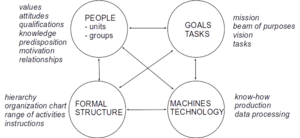Organizational design models
| Organizational design models |
|---|
| See also |
Organization design models present structure, characteristics, operation of existing or proposed object, providing knowledge, information and understanding (e.g., device model, a model of the economy, company model, system model). The word model is also used in sense of: description, structure, method, analog, abstract, theory.
Role of models in science
Models are created in various sciences, including the science of organization and management, and are the result of a process of abstraction. It is built up in order to focus attention on that which is most important, which has a significant impact on the specific process. Therefore, the model ignores the non-essential elements of reality.
Functions of business models
Models being a tool for understanding, has following functions:
- reflectivity (reflection) - the essence of a phenomenon, analogy between the subject and the research model. The analogy provides a description of the object, its interpretation and explanation. There are two types of analogies: structural and functional. Structural analogy reflects the mutual relationships between parts of a whole, and the functional analogy represents behaviour of the modelled object,
- experimental research tools - model replaces the test object and the model test results are transferred to the object. In experimental sciences, models are subject of research (replaces the real object) and the experimental tool (a means for understanding the object),
- abstraction - This feature allows to simplify the test object, leads to the rejection of unimportant, random relationships - interactions,
- communication - model is an important tool of communication, it has the ability to identify complex systems and present it in an intelligible and communicable form,
- control - This feature makes it possible to identify and analyse deviations occurring in the operation of various systems.
Organizational models functions
In practice, there is a huge variety of models that can be classified according to the following criteria:
Modeling objective
- cognitive models - are designed to test knowledge of reality. These models can be divided into descriptive study which constitute a description of reality and explanatory models of cause - effect phenomena occurring in the studied object (forecasting models),
- decision making - are created in order to shape of reality and changing it,
- design - they are designs of measures connected with the development and implementation of new objects
Nature of the analogy that occurs between the model and the object
According to this criterion there are following models:
- substantial - which is a substrate or a set of elements making up the object,
- structural - that is, presenting the structure of the relationships between the elements of the object,
- functional - mapping operation, the behaviour of the object as a whole against external conditions,
Form in which the object is presented
According to this criterion there are following models:
- descriptive - verbal image of the object, taking the form of instruction work-flow cards, scope of activities cards,
- physical - they are constructed of sensory components (e.g., spheres, to scale mechanical systems) that are physically similar to the corresponding elements of the object. For example, the physical model can be used in the spatial organization of work processes (production floor plan, deployment plan in production departments within the company). Physical model may be so-called small-scale laboratory group.
- graphics - symbolic model representation, in which the elements, relationships and properties of an object are shown graphically. For example, drawings used to instruct contractors,
- mathematical - belong to the symbolic model, in which the elements, relationships and properties of an object are presented using mathematical characters, systems of equations and inequalities, which, for a selected set of parameters allow you to calculate the value of the criterion function,
According to model parameters over time
- static - in such model parameters do not change over time. They represent the organizational structure of the whole in the "cross-section" of the moment,
- dynamic - parameters appearing in these models changes in time. Dynamic model gives a picture of each events taking place in the whole system in successive moments of time. This model maps the processes and their dynamics,
Role of models
It should be emphasized the benefits of models is to facilitate the understanding of reality and simplify it, and therefore it is easier to use them than the actual objects. They can reproduce past and present, and are used to create the future.
A special type of model is a model of organization. This model presents simplified picture of organization, showing the basic pattern of organization of its components and material properties (attributes). Shows a subsystems of organization, and the relationships between them. Model allows managers to know the workings of the organization, shows that the organization is a complex system, and there are causal relationships between the components of the organization. The basic model is the model of organization proposed by H. Leavitt (picture 9.1).
References
- Baroudi, J., & Lucas Jr, H. C. (1994). The role of information technology in organization design. journal of management information systems, 10(4), 9-23.
- Daft, R. L., & Weick, K. E. (1984). Toward a model of organizations as interpretation systems. Academy of management review, 9(2), 284-295.
- Galbraith, J. R. (1977). Organization design: An information processing view. Organizational Effectiveness Center and School, 21, 21-26.
- Leavitt, H. J. (1965). Applied Organizational Change in Industry, I JG March (ed.) Handbook of Organizations. Chicago: Rand McNally, 1144, 1170.
- Leavitt, H. J. (1975). Beyond the analytic manager: Part II. California Management Review, 17(4), 11-21.
- Leavitt, H. J. (2005). Hierarchies, authority, and leadership. Leader to Leader, 2005(37), 55.
Author: Krzysztof Wozniak
